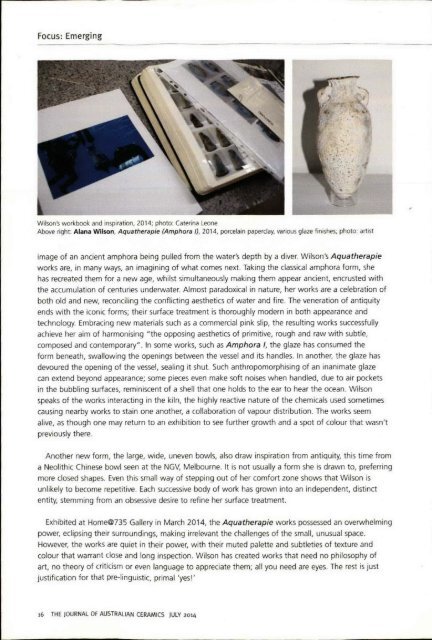The Journal of Australian Ceramics Vol 53 No 2 July 2014
You also want an ePaper? Increase the reach of your titles
YUMPU automatically turns print PDFs into web optimized ePapers that Google loves.
Focus: Emerging<br />
Wilson's workbook. and inspiration, <strong>2014</strong>; photo: Caterina leone<br />
Above right: Alana Wilson, Aquatherap;e (Amphora I), <strong>2014</strong>, porcelain paperday. various glaze finishes; photo: artist<br />
image <strong>of</strong> an ancient amphora being pulled from the water's depth by a diver. Wilson's Aquatherapie<br />
works are, in many ways, an imagining <strong>of</strong> what comes next. Taking the classical amphora form, she<br />
has recreated them for a new age, whilst simultaneously making them appear ancient, encrusted with<br />
the accumulation <strong>of</strong> centuries underwater. Almost paradoxical in nature, her works are a celebration <strong>of</strong><br />
both old and new, reconciling the conflicting aesthetics <strong>of</strong> water and fire. <strong>The</strong> veneration <strong>of</strong> antiquity<br />
ends with the iconic forms; their surface treatment is thoroughly modern in both appearance and<br />
technology. Embracing new materials such as a commercial pink slip, the resulting works successfully<br />
achieve her aim <strong>of</strong> harmonising "the opposing aesthetics <strong>of</strong> primitive, rough and raw with subtle,<br />
composed and contemporary". In some works, such as Amphora /, the glaze has consumed the<br />
form beneath, swallowing the openings between the vessel and its handles. In another, the glaze has<br />
devoured the opening <strong>of</strong> the vessel, sealing it shut. Such anthropomorphising <strong>of</strong> an inanimate glaze<br />
can extend beyond appearance; some pieces even make s<strong>of</strong>t noises when handled, due to air pockets<br />
in the bubbling surfaces, reminiscent <strong>of</strong> a shell that one holds to the ear to hear the ocean. Wilson<br />
speaks <strong>of</strong> the works interacting in the kiln, the highly reactive nature <strong>of</strong> the chemicals used sometimes<br />
causing nearby works to stain one another, a collaboration <strong>of</strong> vapour distribution. <strong>The</strong> works seem<br />
alive, as though one may return to an exhibition to see further growth and a spot <strong>of</strong> colour that wasn't<br />
previously there.<br />
Another new form, the large, wide, uneven bowls, also draw inspiration from antiquity, this time from<br />
a Neolithic Chinese bowl seen at the NGV, Melbourne. It is not usually a form she is drawn to, preferring<br />
more closed shapes. Even this small w ay <strong>of</strong> stepping out <strong>of</strong> her comfort zone shows that Wilson is<br />
unlikely to become repetitive. Each successive body <strong>of</strong> work has grown into an independent, distinct<br />
entity, stemming from an obsessive desire to refine her surface treatment.<br />
Exhibited at Home@735 Gallery in March <strong>2014</strong>, the Aquatherapie works possessed an overwhelming<br />
power, eclipsing their surroundings, making irrelevant the challenges <strong>of</strong> the small, unusual space.<br />
However, the works are quiet in their power, with their muted palette and subtleties <strong>of</strong> texture and<br />
colour that warrant close and long inspection. Wilson has created works that need no philosophy <strong>of</strong><br />
art, no theory <strong>of</strong> criticism or even language to appreciate them; all you need are eyes. <strong>The</strong> rest is just<br />
justification for that pre-linguistic, primal 'yes!'<br />
16 THE JOURNAL OF AUSTRALIAN CERAMICS JULY <strong>2014</strong>

















